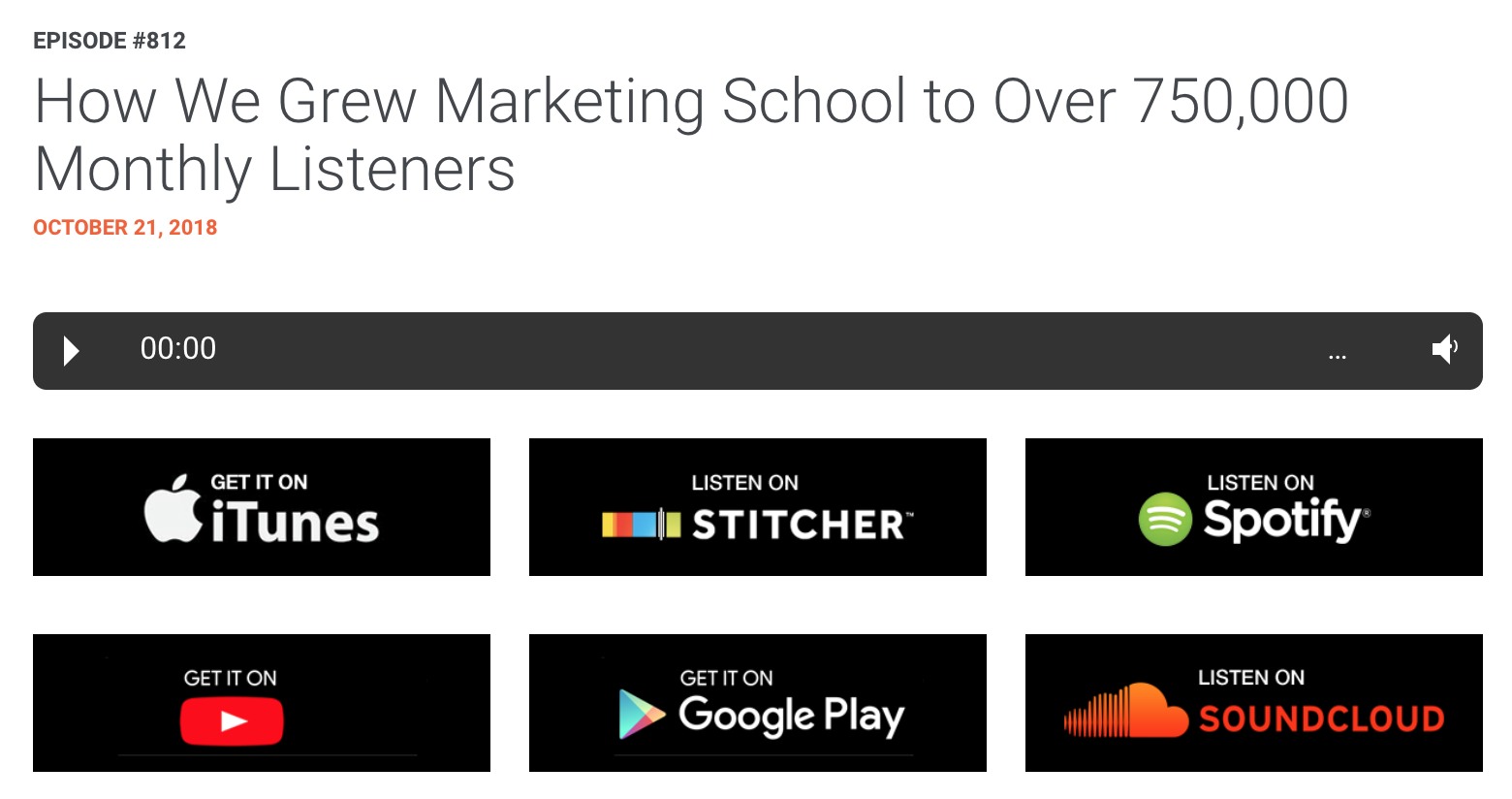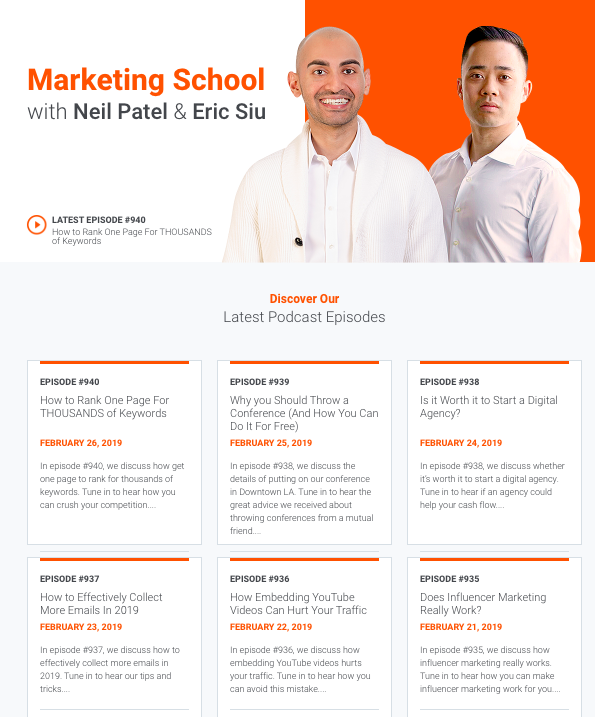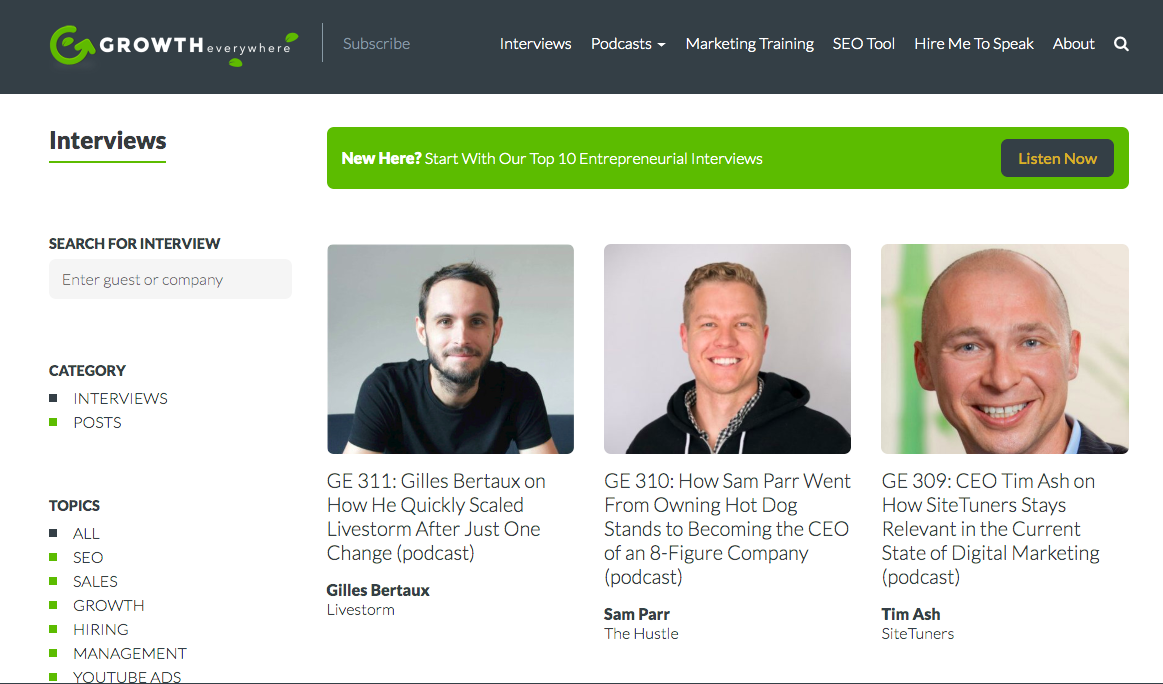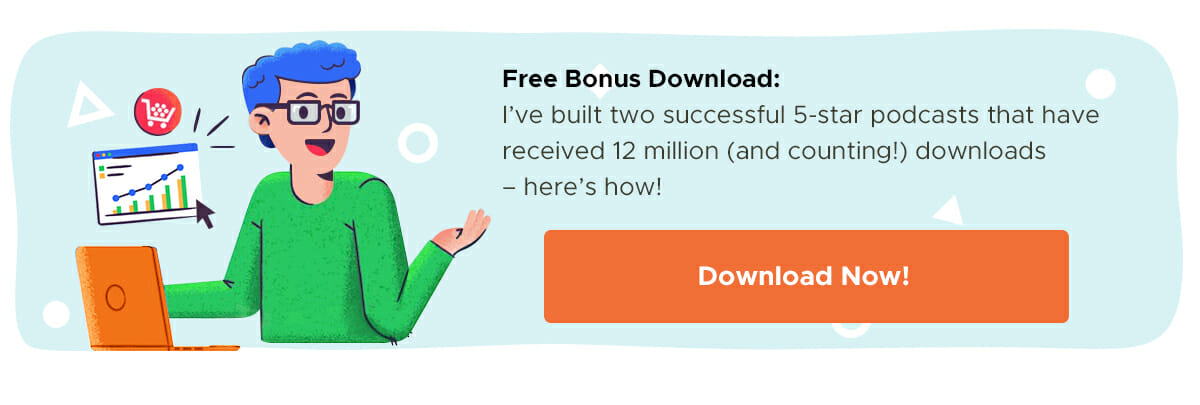If you look at people with 10K, 500K or even 1M followers on their blog or YouTube channel, you think they must be special, right? No normal person could get to that level.
I’m here to tell you that’s not true. Anyone can build a massive audience. I’ve done it myself many times. It’s not magic and it’s not because I’m special; you just need to follow the proven steps, which is what we did with Marketing School:

Now, do I guarantee that you’ll get to that level? No. Because you need to put in the work. If you’re not committed to doing it, of course it won’t happen.
But if you follow this advice and turn up every day with the right attitude, there’s no reason why you can’t gain huge numbers. So, here are the proven steps to building an audience in 30 days.
Phase I – Become a Content Machine
1) Get Focused
The first thing you need to do on day one is think about the platform that you’re going to be on and the topics that you’re going to cover. Duh, right?
But here’s the thing: One of my friends started a podcast with a buddy and they had no idea what they were talking about. They were just rambling about whatever came into their heads.
I asked him, “Who owns this podcast? Are you guys 50/50?”
He said, “Uhh, I don’t know, I’m just helping him.”
When things are unclear and you’re not even really trying, you have no dignity. And what happens is that the podcast ends up folding because you don’t know what you’re doing and you have no direction. If you don’t know what you want to say, your audience isn’t going to be engaged. They won’t stick with you.
So you have to have a sense of what you’re going to talk about. If you’re working with somebody else on it, you have to map out:
- Clear expectations
- Clear guidelines
- Clear responsibilities
Otherwise, you’re setting yourself up for failure.
2) Batch Content Creation
It doesn’t matter if you decide to start with a podcast, blog posts or even video – batching will save you time and headaches.
Once you choose your topic, record at least five at a time so you come flying out of the gate when you launch. This way, you’re not constantly worrying about the next one and the one after that, because you already have five in the can. Batching content helps you avoid chasing your tail.
Here’s the cool thing. If you’re doing podcasts – let’s say you’re doing one per week and you start with five – then you’re good for the next five weeks and you can start thinking about what else you need to do and which other topics you want to cover. Then you can start to build your base and go from there.
Dive Deeper:
- How to Build a High-Performance Content Marketing Strategy
- 5 Great Ways to Ideate for Your Blog Posts
- 7 Creative Ways to Monetize Your Podcast
- How to Make a Video That People Will Watch Til the End
3) Get Help From Guests
If you’re just launching, you won’t have an audience yet. But if you’re interviewing people on your podcast or videos, get those people to help you with promotion.
Say, “Hey, look, I could use your help promoting this,” and they might send it to their email list or share it on their social networks. The least they might give you is a Tweet. You might get two people, five people, 10 people, etc. listening to it. That might not seem like a lot, but once they start to share your content, you’ll get bigger and bigger until you’re able to grow on your own.
It’s important for you to get the promotion going right from the start or you’ll never get moving.
Dive Deeper: The Most Underrated Tactic to Boost Your Search Ranking: Podcast Guesting
4) Keep It Consistent
You’ve got to set a cadence in the beginning, whether it’s going to be weekly, daily or whatever. If you’re doing a podcast or even if you’re doing video, I would recommend, that you do it daily. If I were starting from scratch today, that’s what I’d do.
With Marketing School, the podcast I do with Neil Patel, we release an episode every single day. That’s 30 episodes every month. How do we do it? We batch it (see #2 above). We record 20 episodes in a day, and then another day of the same month, we do another 20 episodes. So we get 40 done per month. That means we always have a surplus of 10. And usually we’re ahead by another month.

Growth Everywhere is my weekly podcast where I interview someone on each episode. I do it all on Thursdays and I will do two or three interviews in a day. So each month I’m probably getting 8 to 12 interviews. Sometimes I might do four in a day, which would then get me up to 16 in a month. That allows me to remain consistent with my output. If I were recording only one per week, what happens if I can’t lock down an interview one week? There’d be no show that week.

Right now with Growth Everywhere, I’m ahead by six or seven months. So I can go on vacation right now, not do anything for the longest time, then come back, make some more, then go on another vacation after that, and I’ll still be ahead of schedule. That’s the peace of mind that I have right now.
I recommend that you do it daily. Why? Because most other people aren’t, so you’ll already be ahead of the pack.
When I create content, when I get hardwired for it, I find I’m able to easily think about what I want to do next, what I want to talk about, what I want to apply to my business, how I’m thinking about things. Maybe there’s something I want to articulate. When you have this mindset, you can produce endless content.
You’ve got to be consistent or you’re letting your audience down. Whatever schedule you choose, produce content by the batch, get ahead and stay consistent.
Dive Deeper:
- Why I Decided to Start Podcasting
- How We Built the Growth Everywhere Podcast to 109,000 Listens per Month
5) Repurpose Content Over and Over
Say you’re starting with a batch of 10 videos. Those videos can become audio files, too, in no time at all, which means that now you’ve got video and audio content. Then you can make transcripts and turn them into blog posts. Then create an infographic out of some of the stats you talk about.
Different people consume your content in different ways, so don’t worry about repetition. By repurposing and putting content out in different ways, through different channels, more people will see it.
And videos serve a different purpose to podcasts or blog posts. For example, you can go into more depth in a podcast. You can use links in a blog post and have a CTA at the end. It’s worth exploring all the options.
This is the content sprouting method that we talk about a lot. You take one piece of content, like a video, and turn it into audio then a blog post, etc. Say you turn your daily videos into 30 podcasts, and then turn these into four blog posts. Now you have a machine because you’re creating 64 pieces of content in a month. Do that over a year and you’ve created 768 pieces of content. You’re basically a publisher!
Dive Deeper:
- The #1 Marketing Strategy for 2019: The Content Sprout Method
- 9 Ways to Repurpose Your Old Blog Content
- How Writing One Piece of Remarkable Content Can Change Your Business…and Your Life
- Do You Really Need to Write 1,890-Word Blog Posts to Rank on Page 1?
Phase II – Promotion
Let’s take stock. You started out with a topic, you picked a platform, you get your guests to promote it a little bit. You remained consistent and you’re a content machine.
These are the first things that you need to do to start becoming successful. Then you can think about promoting for real and growing your audience.
6) Ignore Social Media
This is going to be controversial, but I would ignore social media in the beginning because you just don’t have the time for it. You have to prioritize. If you’re starting from scratch, you might not have many resources.
Your audience might be hanging out on Instagram, so it might not make sense to do a podcast. Maybe it does, maybe it doesn’t, but you’ve got to think about where your audience is spending their time and then produce content that’s native to them and think about what works best for you.
If you can fit in social media, go for it. But it’s more important to stick to your core content schedule.
7) Collaborate
At this point, you can start to think about collaborations. This goes further than just having a guest on your podcast. This is more of a trade.
Collaborating with other people will make you stronger. Choose people who have a large audience if you have no audience to begin with. You can leverage their audience, but it’s got to be done in the right way.
Let’s say someone has 10,000 followers and you have zero but you happen to be good at SEO. Offer your SEO services to that person. Say, “Hey, look, let’s barter a little bit. I’ll give you some SEO services and in return, I’d like you to be on my podcast and I’d like you to help promote me a little bit. I’d also like to do something on your YouTube channel. This is the value of my SEO services. Would you be interested in doing that?”
It’s important to balance the value here. If you don’t have someone who’s apples-to-apples in terms of follower count, you have to add something else valuable so they feel it’s an equal trade. If it’s not an equal trade, they’re just going to ignore you. They’re going to laugh at you. Also, they’re gonna hate you because you didn’t think about what is equitable and you’re wasting their time and being selfish.
Just because you put the work into it in the beginning, does not mean that you deserve to have an audience. The audience takes time.
When I started the Growth Everywhere podcast, I spent six to eight hours a week on it. I was only getting nine downloads a day after the first year. Only 30 downloads a day after the second year. So was I entitled? No. Was I sad? Yes. It took a long time to build an audience to 100,000 a month. But this led to another podcast, which has 1.1 million downloads a month now.
This stuff takes time. This is just the beginning. Do the things that matter foundationally, and you start to build the habit. It’s just like when you go to the gym working out. In the beginning, you can’t pull up a 45-pound bar. You see everyone else doing two plates and then you’re just like, “Oh, God, what am I doing here?”
But by working on it a little at a time every day, or a few times a week, eventually you can get there yourself. You can get up to two plates. Maybe you can get up to three plates. Who knows how far you can go?
Dive Deeper: The Ultimate Guide to Growing Your Business with Influencer Marketing
8) Forget the Audience
That’s right – your aim is to build an audience, but that shouldn’t be your day-to-day focus.
For me, talking to my audience regularly helps me get better at my craft. That’s why you create content in the first place, to get better at your craft.
Forget the audience thing. Building the audience is almost like a side effect. Your audience starts to form once you start to form a point of view. You don’t form a point of view until you start to talk about it, until you start to develop your own voice.
When you start to develop your own voice, you’ll find that you’re not following people as much anymore. It’s totally fine to follow people in the beginning, but as you develop more experience, you won’t be following people as much and you’ll become your own person. It’s very invigorating and very freeing at the same time.
9) Create Ego-Bait Pieces
We talked about getting guests on your show. But if you can’t get guests, there are other ways to get your stuff in front of more people.
I’ll give you an example in terms of blogging, but this applies to other forms of content, too. When I started blogging, I used to always write ego-bait pieces. For example, The 50 Top Entrepreneurs to Follow or 50 Top Marketers to Follow.
And I’d reach out to every single one of them. Because there were 50 in the list, maybe 10% might respond, which is just five of them. But that’s a good result if they Tweet you. And that’s what started to get my name moving. When I started the Growth Everywhere podcast, people slowly found out about me, but it took two years to really get going.
Don’t worry about the audience size so much. Take Marketing School. It gets 1.1 million downloads a month and Growth Everywhere is only about 100,000, but you know what? More people, when they come up to me, talk to me about Growth Everywhere. Maybe 60% of the time, they talk about Growth Everywhere versus Marketing School. So it’s not always about the numbers. That can sometimes be a vanity metric.
And at the same time, you have to consider that people who listen to one particular podcast might be a lot more affluent. Would you prefer a podcast that gets a thousand downloads a month, but it’s all millionaires and billionaires listening to it? Or one that gets a million downloads a month and it’s all people who are just starting out in life?
It just depends on what you’re looking for and who you’re planning to sell to. You’ve got to know who you’re targeting.
Dive Deeper:
- Why Content Marketing Should Always Be 20% Creation and 80% Promotion
- How to Implement User Intent to Build an Audience for Your Content
- How to Research Your Audience Before Producing an Explainer Video
- Copywriting Hacks: How to Build Trust With Your Audience
10) Look at Your Analytics
You need to look at your analytics if you want to build a good audience. Look at your top-performing blog posts, look at your top-performing videos, look at your top-performing podcasts. If you find something that works, a title that works, do it again!
Look at the stuff that performs, try to double down on those, and maybe 20-30% of the time, try new things that you haven’t done before and just keep experimenting. 20-30% is more than enough. The other 70-80% of the time, do the stuff that works. You’re going to figure out the stuff that works through quantitative and qualitative feedback. So once you start to build a little bit of audience, survey them as well.
What do they want to know? What do they like? What do they want to see more of? Find the answers and give them what they want!
The Flywheel Effect
A wheel is really hard to turn in the beginning because of inertia, right? Without going into the physics, it’s hard to move something in the beginning, but once you get it moving, the wheels are easier to move. Those first couple of turns start to build momentum and then they move a lot faster, and boom! You’re cranking.
And that’s how you build an audience. I’ve seen the same pattern over and over with Growth Everywhere, the Single Grain blog and our YouTube channel. We started at 2,500 subscribers and now we’re at 20,000. The more that people subscribe, the more they share, and when new viewers see the numbers, there’s more credibility, so they subscribe, too.
I’m gonna emphasize this again: it’s going take you time, so you have to be patient and you have to just keep doing what works. Remember, success compounds, so if you’re patient and have a unique point of view, you’re going to do great.
Watch parts 1 & 2 of the video of this blog:







